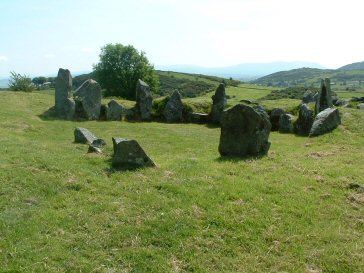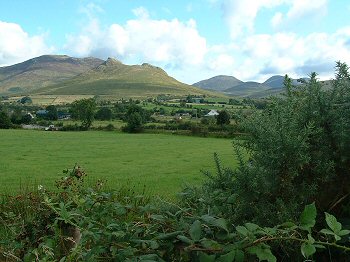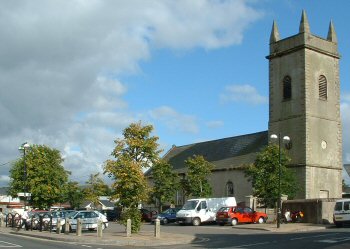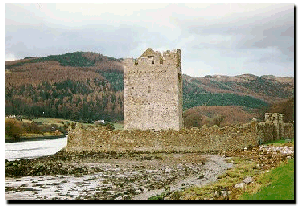
| south
armagh |
|
The
Ring of Gullion area of South Armagh has a striking landscape with a
fascinating history. This, and its varied wildlife and heritage features,
reflect the complex physical structure of the rocks. Surviving today is a
rich variety of historical monuments and many distinct features which have
evolved with time. The area sits astride ancient and modern lines of
communication and throughout history, warfare and defence have been
recurrent themes. Most buildings of historic interest (farms, mills,
rectories and old estate houses and outbuildings) are in private
ownership. Many of the traditional single-storey farmhouses however are
now derelict. The heather-clad Slieve Gullion mountain towers over
farmland minutely divided by dry stone walls and hedgerows.  The feeling of
enclosure is emphasized by the outer ring of rugged hills, their
contrasting land use and vegetation closely reflecting the general
topography. Overall the area is reminiscent of Ireland's west coast. The feeling of
enclosure is emphasized by the outer ring of rugged hills, their
contrasting land use and vegetation closely reflecting the general
topography. Overall the area is reminiscent of Ireland's west coast.

One of the most
important cultural resources of the area is the Irish language.
In the south and west of the area, Irish is still the second language for
some local people, particularly in the older age bracket. In recognition
of this vital human resource a new summer school has opened recently to
introduce visitors to the Irish language and unique culture of the area.
The area is also rich in local literature and music. The literature gives
a unique insight into the area's social history. This too is closely
linked to the local landscape and society, and provides South Armagh with
its unique identity. The weekly music sessions in many pubs reflect the
dynamic of traditional music here. In addition the vibrant local community
organises many events and festivals of traditional music, song and dance.
Their number grows annually and their fame has spread far and wide. They
now attract participants and visitors from America, Australia, Great
Britain, many countries of Europe and of course the Republic of Ireland.
Some such are the increasing Clan Reunions, the Winter School at
Mullaghbawn, the Lislea Drama Festival and the Forkhill Song Festival.
Successful lectures and seminars are held regularly on many topics from
Irish history. (See Entertainment)
The Slieve Gullion
Courtyard Centre is an attractive quadrangle of listed buildings sited on
the former Chambrés' Estate, originally built in 1820 as a farmstead. It
is now a Heritage and Education Centre and provides accommodation in
self-catering apartments for groups of up to forty people a restaurant and a craft workshop and conference facility. The courtyard
stands in the Slieve Gullion Forest Park with magnificent views of the
countryside. The idyllic Forest Park setting is further enhanced by its
location within the Ring of Gullion, an Area of Outstanding Natural Beauty
(AONB). For contact information click here.
Tí Chulainn This is
an Irish cultural and heritage centre located in Mullaghbawn. This centre
also provides accommodation, a restaurant, a craft workshop, a bookshop
and an exhibition area. |
| mourne
mountains |
 The Mourne
Mountains hold great appeal for the rambler, the climber and the hiker.
They are a ring of steeply sloping, granitic mountains. Fourteen of the
peaks are higher than 2000 feet. The Mournes sweep down to the sea at
several places, most notably at Newcastle which is a large, popular and
picturesque seaside resort with a long sandy beach and numerous holiday
facilities.
The Mourne
Mountains hold great appeal for the rambler, the climber and the hiker.
They are a ring of steeply sloping, granitic mountains. Fourteen of the
peaks are higher than 2000 feet. The Mournes sweep down to the sea at
several places, most notably at Newcastle which is a large, popular and
picturesque seaside resort with a long sandy beach and numerous holiday
facilities.
 The rugged nature of the slopes means that only sheep graze here among
heathers, bracken and coarse grass, occasionally kept from the marginally
better land by old dry-stone walls.
The Mournes also sweep seaward at
Rostrevor and Kilkeel and on the landward side to the villages of
Castlewellan (which has a forest park not to be missed!) and Hilltown.
The rugged nature of the slopes means that only sheep graze here among
heathers, bracken and coarse grass, occasionally kept from the marginally
better land by old dry-stone walls.
The Mournes also sweep seaward at
Rostrevor and Kilkeel and on the landward side to the villages of
Castlewellan (which has a forest park not to be missed!) and Hilltown. |
|
|
| murlough
nature reserve |
The Murlough
Nature Reserve was the first of its kind in Ireland. It is a
dune system situated just north of Newcastle, and provides an
excellent opportunity for walking, birdwatching or lying on the
beach.
|
| archaeology |
Mysterious
stone tombs and monuments are found all over Ireland. These
structures are thousands of years old, and many can be found in
the Newry area. Examples are Kilnasaggart Cairn (pictured
above), Ballykeel Dolmen, Ballymacdermott Court Cairn (pictured
above) and Navan Fort.
|
| Kilkeel |
Kilkeel, the
North's premier fishing port lies, like Newcastle, where the
Mountains of Mourne sweep down to the sea. The town has
excellent recreational facilities, including a golf course at
Mourne Park. As well as being a resort town, it is home to a
large fleet of fishing boats. A 14th Century ruined church is
situated in the town centre. A new state-of-the-art swimming
pool is under construction.
|
| Cranfield
and Greencastle |
Cranfield is a beautiful and popular beach with many modern facilities. It
is excellent for swimming, picnicing and camping. Just a few miles north
of Cranfield is Greencastle - so named because of its tall turretted
castle built by the Anglo-Normans in 1261 to complement their
fortifications at Carlingford on the opposite shore of the Lough.
|
| warrenpoint |
 Warrenpoint
is another coastal resort with excellent facilities. People
flock to Warrenpoint in the summer months to play golf, tennis
and a wide variety of water sports. Some choose to visit the
friendly pubs and restaurants while others just stroll along the
promenade, or hop on the ferry to Omeath a mile away but in the
Irish Republic. Narrow Water Castle (below) is well worth a
visit. Warrenpoint
is another coastal resort with excellent facilities. People
flock to Warrenpoint in the summer months to play golf, tennis
and a wide variety of water sports. Some choose to visit the
friendly pubs and restaurants while others just stroll along the
promenade, or hop on the ferry to Omeath a mile away but in the
Irish Republic. Narrow Water Castle (below) is well worth a
visit.
|
| rostrevor |
Rostrevor is
within walking distance of Warrenpoint. It is a picturesque
village boasting the pretty Fairy Glen and Kilbroney Forest
Park, an excellent starting point for rambling or hiking in the
Mourne Mountains. Cloughmore Stone is a glacial erratic situated
on top of Slieve Meen overlooking Rostrevor.
|
| bessbrook |
Bessbrook is
a 'model' village built from Mourne Granite by a wealthy Quaker
linen manufacturer named Richardson to house his workers. He
imposed a ban on pubs and pawnshops and to this day the village
still has neither facility.
|
|